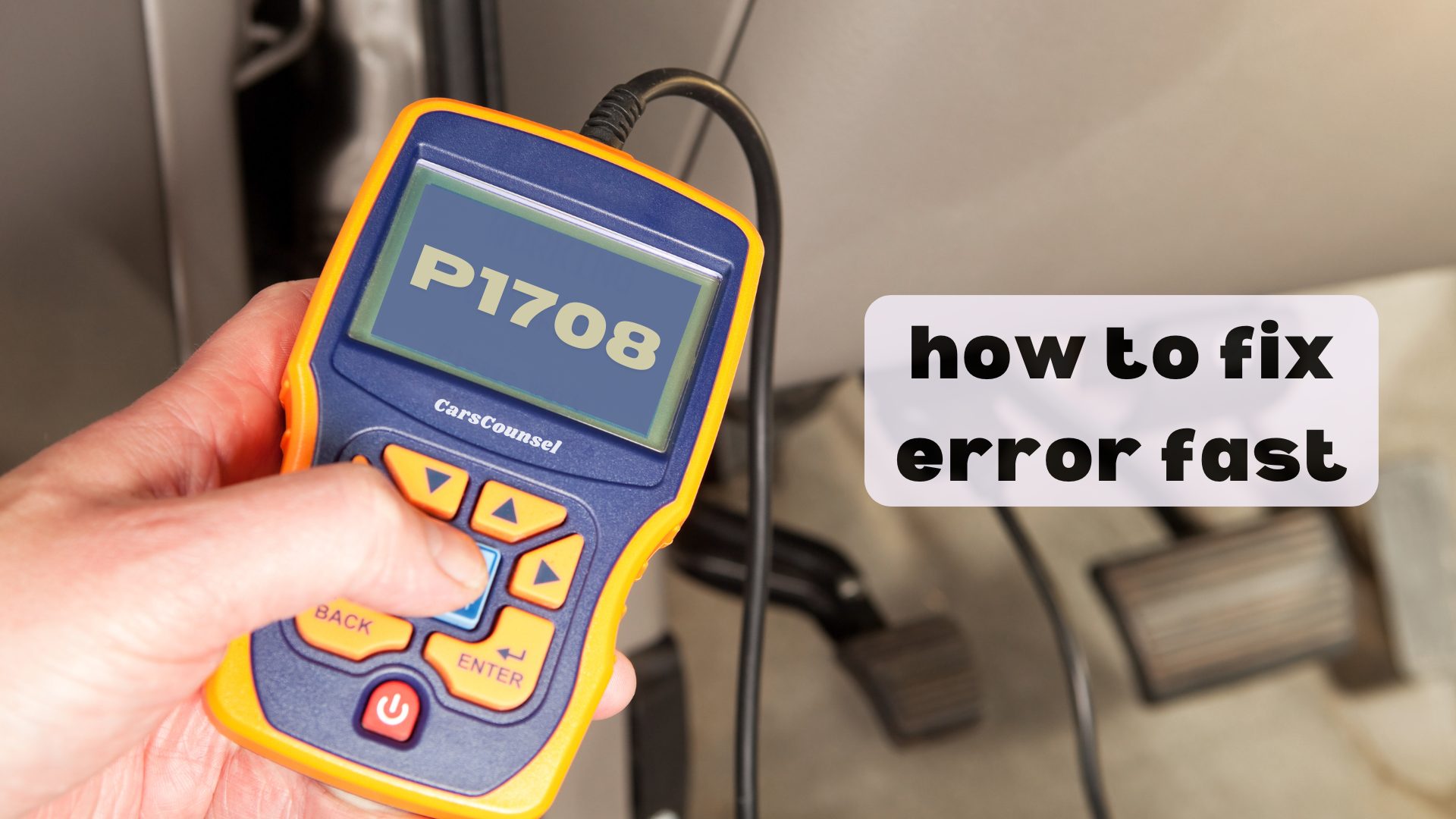When your vehicle’s onboard computer throws a P1708 code, it’s telling you that the accelerator switch is malfunctioning. This switch plays a critical role in regulating throttle position, so it’s no surprise that issues with it can lead to problems with acceleration, fuel efficiency, and overall engine performance. You may have already noticed symptoms like loss of power, engine misfires, or rough idling.
But what’s causing the problem, and how do you fix it? Understanding the root cause of the issue is key to getting your vehicle running smoothly again – and that’s exactly where we’re about to head next.

Quick Navigation
Key Takeaways
- The P1708 code indicates a problem with the accelerator switch, affecting engine performance, acceleration, and fuel efficiency.
- A faulty accelerator switch can cause loss of power, engine misfires, rough idling, and inconsistent throttle response.
- Common causes of the P1708 code include faulty switches, wiring issues, corrosion, and environmental factors like moisture or heat exposure.
- To diagnose and repair the issue, use a scan tool to retrieve the code, check wiring and connectors, test the accelerator switch, and clear the code.
- Regular maintenance, switch cleaning, and inspections can help prevent the P1708 code from recurring and ensure peak engine performance.
Understanding Code P1708
When your vehicle’s onboard computer stores a P1708 code, it’s a clear indication that there’s a problem with the accelerator switch.
This switch plays a vital role in your vehicle’s performance, sending signals to the engine control module (ECM) to adjust the throttle position based on your input.
As part of regular vehicle maintenance, it’s essential to address this issue promptly to prevent drivability problems and engine stalling. A malfunctioning accelerator switch can lead to issues with acceleration, fuel efficiency, and overall engine performance.
Understanding the accelerator overview and how it interacts with the ECM is vital in diagnosing and resolving this problem. By staying on top of vehicle maintenance, you can avoid more costly repairs down the road.
Common Causes of P1708
Faulty accelerator switches are the most common culprits behind the P1708 code, but they’re not the only ones.
You’ll need to investigate switch failure modes, such as worn-out contacts or corrosion, to determine the root cause.
Wiring issues or short circuits can also trigger the fault code, so a thorough wiring harness inspection is essential.
Corrosion or damage to connectors can also be a contributing factor, so make sure to check for any signs of wear or damage.
Additionally, environmental factors like moisture or heat exposure can cause the accelerator switch to malfunction, leading to the P1708 code.
Symptoms of Accelerator Switch Failure
You may notice a decline in your vehicle’s performance when the accelerator switch fails, and it’s essential to recognize the symptoms to address the issue promptly.
A faulty accelerator switch can cause a range of problems that’ll leave you feeling frustrated and concerned about your safety on the road.
Some common symptoms of accelerator switch failure include:
- Loss of power or acceleration, making it difficult to merge or climb hills
- Engine misfires or hesitation, causing your vehicle to stumble or jerk
- Rough idling, making it hard to maintain a steady speed
- Inconsistent throttle response, leading to unpredictable acceleration
- The Check Engine Light illuminating, indicating a problem with the accelerator switch or other engine components
Recognizing these symptoms early on can help you avoid more serious problems down the road, such as faulty pedals or worn connectors.
Diagnosing and Repairing P1708
Diagnosing and repairing the P1708 code requires a systematic approach to identify the root cause of the problem.
You’ll need to use a scan tool to retrieve the code and pinpoint the specific issue with the accelerator switch. Check the wiring and connectors for damage or corrosion, and repair or replace them as needed.
Next, test the accelerator switch for proper functionality and replace it if faulty. After repairs, clear the code and perform a test drive to verify the issue has been resolved.
If the problem persists, further diagnostic testing may be required, including accelerator calibration to guarantee proper throttle response.
Accelerator Switch Replacement Cost
The cost of replacing the accelerator switch can vary significantly depending on the make and model of your vehicle, as well as the extent of the repair needed.
You’ll want to get an accurate estimate from a professional mechanic or auto repair shop.
The type of accelerator switch required for your vehicle, the complexity of the repair, including any additional components that need replacement, the labor rates of the mechanic or shop you choose, the location where you live, as labor rates can vary by region, and any additional diagnostic time needed to identify the root cause of the issue can all affect switch pricing and labor estimates.
- The type of accelerator switch required for your vehicle
- The complexity of the repair, including any additional components that need replacement
- The labor rates of the mechanic or shop you choose
- The location where you live, as labor rates can vary by region
- Any additional diagnostic time needed to identify the root cause of the issue
Troubleshooting Accelerator Switch Issues
What’s causing your accelerator switch to malfunction?
To troubleshoot the issue, start by checking the switch’s maintenance history. Has it been properly cleaned and inspected recently? Corrosion or dirt buildup can affect its performance.
Next, review the throttle calibration settings. Are they correctly configured? Incorrect settings can lead to inconsistent throttle response.
Inspect the wiring and connectors for signs of damage or corrosion. Perform a voltage test to verify the switch is receiving the correct power supply.
If you’re still unsure, consult a professional mechanic or repair manual for further guidance. By following these steps, you’ll be closer to identifying the root cause of the P1708 code and getting your accelerator switch back in working order.
Preventing P1708 Code Recurrence
Now that you’ve identified and addressed the P1708 code, it’s time to take proactive measures to prevent its recurrence.
To avoid revisiting the same issue, prioritize regular maintenance and switch cleaning to keep your accelerator switch in top condition.
Clean the accelerator switch and surrounding connectors regularly to prevent corrosion and debris buildup.
Inspect the wiring and connectors for signs of wear or damage and replace them as needed.
Avoid exposing your vehicle to extreme temperatures, moisture, or environmental stressors.
Perform routine tune-ups and engine maintenance to guarantee peak engine performance.
Consider using a fuel injector cleaner to prevent fuel system buildup and maintain efficient engine operation.
Professional Assistance and Resources
One crucial aspect of P1708 code diagnosis and repair is seeking professional assistance when needed.
If you’re not experienced in troubleshooting and repairing complex engine issues, it’s recommended to consult a professional mechanic or visit a reputable repair shop.
They’ll have the necessary expertise and equipment to accurately diagnose the problem and perform the required repairs.
Ask for mechanic recommendations from friends, family, or online reviews to find a trustworthy shop.
Be sure to provide them with as much information as possible about your vehicle’s symptoms and the P1708 code to guarantee they’re prepared to tackle the issue efficiently.
More OBD-II Codes
Conclusion
As you shift gears and hit the open road, your accelerator switch is the unsung hero, harmoniously synchronizing engine and pedal. But when it falters, the P1708 code flashes like a warning lighthouse, signaling a breakdown in this intricate dance. Don’t let the music stop – address the issue promptly to avoid a discordant driving experience. With the right diagnosis and repair, your engine will hum in perfect harmony once more, and the road ahead will be yours to conquer.

